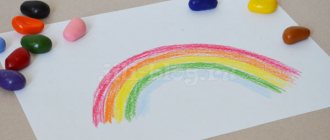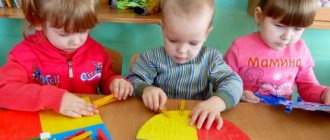- April 22, 2019
- Preschoolers
- Svetlana Funtova
When it comes to child development, most parents become obsessive, to put it mildly. They worry about when the baby should start walking and talking, at what age children should know colors and shapes. A characteristic such as color is not sufficiently isolated, so the child needs time to master it. Thanks to the following recommendations and the games presented, any parent will be able to quickly teach their child to distinguish and name shades.
When to teach a child to distinguish colors
Children know that objects have their own color from infancy. However, they cannot tell this until they learn to talk. Consequently, babies are able to distinguish and name colors well only when they reach a certain level of development.
Pediatricians and child psychologists recommend starting the learning process as early as possible, as this promotes active brain function and intensive accumulation of information, which will subsequently be better absorbed and applied. To properly approach the issue of education, parents should know at what age children distinguish colors:
- black and white – the first 1-2 months;
- yellow and red – from 3-4 months;
- green and blue – from 4 months;
- mastering space and understanding colors that are far away - 5-8 months;
- at 9-12 months the child sees all colors at any distance and may give preference to any shade.
It is from the age of four months that the baby can distinguish between bright and dull shades, large and small objects. At this time, the child already clearly understands whether there is color or not. We looked at when a child begins to distinguish colors. But when do you teach them what they are called?
You can begin to memorize shades for children as young as two years old, although many children do not yet speak. If at this age your child is unable to sort objects by shape, size and color, there is no need to worry. With regular practice, by the age of three, the baby will be able to name objects and give them a simple description by color and shape. Within normal limits, if he gets confused or makes mistakes.
According to psychologists, preschool children may exhibit disturbances in color perception. The cause for concern is that by the age of 7 the child has not learned to distinguish colors.
Principles of formation of color perception functions in a child
Before starting to study practical tips and techniques, parents need to familiarize themselves with some features of the development of visual functions in children.
This will help you use the acquired knowledge in the right way. So, a child’s ability to focus on any object appears at the age of 2-3 months. Usually the first thing a baby learns to distinguish is the mother's breast. This is due to the fact that at this age the color perception of the child’s eye is adjusted in such a way that the child can clearly see the mother’s nipple. The colors that he can distinguish between 2 and 6 months are in the wavelength range of a wide spectrum: red, pink, brown. The ability to distinguish short wavelength colors, blue and green, appears closer to the seventh month of life, and full color perception is formed in a child by the age of eight.
Tips and tricks from experienced moms and dads
Now that we know the basic principles of forming children's perception of the color palette, we can begin to study recommendations and advice from more experienced parents.
- Teach from an early age. Don't underestimate children's learning abilities. Even if a child cannot speak yet, this does not mean that he is not able to understand or remember something. If you regularly communicate with your baby and tell him what color, for example, his favorite rattle is, this will definitely stick in his head. And in the future, when he can consciously construct different words, it will be easier for you to explain the difference between one color or another;
- Link new knowledge to emotions. Human memory is designed in such a way that we best remember pictures, vivid images and emotions. It’s not for nothing that they say: a person will remember not what you did for him, but what you made him feel. Use this technique in teaching children. For example, start learning colors with your favorite fruit;
- Practical use. New knowledge should be used immediately by the child. If you have learned something new with your baby, try to make sure that he begins to apply it in life. You have learned the color red, so when you are going to go out, ask him to bring you his red jacket. The more often you encourage your child to apply what they have recently learned, the better they will remember it all;
- Encourage your child to share what he has learned with others. After you've learned a new number or color, have your child call grandparent and tell him about it. This principle works very effectively in conjunction with practical application. For example, dad came home from work in the evening and went to wash his hands before eating - let the baby give him a yellow towel;
- Speak in different phrases. Always say color in different contexts so that the child does not perceive it as one word: this is a red ball, the ball is red, this is a ball, it is red, etc.;
- Avoid diminutive words (little blue, red);
- Hold off on the shades - it’s better to leave all light green, pink and blue shades for later;
- Do not start learning a new color until the child has mastered the previous one! (We start with red, and then get acquainted with yellow, green, blue).
Although this article is about how to teach your child to distinguish colors, the principles outlined above apply to more than just that. Using them, you can learn both letters and numbers. Below we will look at several effective techniques that will help parents teach their children about the color palette.
Recommendations for getting to know color
Psychologists and educators can tell parents at what age children should know colors and help with individual lessons with a specific child. In some cases, children are not able to differentiate colors correctly until they are three or four years old. However, starting from one and a half years old, you can try color identification tasks.
The study of colors can be divided into several stages. Before you start learning the names of the shades, you need to make sure that your baby can distinguish them.
At two years old, children are offered simple exercises to sort objects by color. They start with 2-3 colors, for example black and white, and it is important that the objects are the same. That is, the baby should try to separate circles of 2 colors, red and white beans, etc. By the way, this exercise develops motor skills well.
After mastering this sorting, proceed to more complex exercises. One of them is sorting colorful objects with a spoon or tweezers. This activity is suitable for children aged 3 years and older, when coordination of movements is quite well developed.
Activities with an older child
At 2-3 years old, you can offer your baby a solution to the simplest problems, during which he will learn colors together with his mother. The following options are possible.
- The parent draws several cars, and the quality of the drawing does not really matter, the main thing is to paint them with different colors. After this, he gives the child a set of cards or buttons, the color of which matches the color of each car. The baby’s task is to build “paths” for the cars so that they match the tone. The exercise also trains fine motor skills well and, accordingly, is useful for speech development.
- We are building a train. The parent places one cube of any tone that is already familiar to the baby, for example blue. The kid’s task is to continue the train, finding all the cubes that are blue.
- Collect a flower. Mom draws simple flowers (the middle and several large petals) with colored felt-tip pens, then cuts them in half and mixes them. Next, he asks the child to collect flowers, make a bouquet, and name all the colors used.
This type of task helps little ones correctly sort objects, determining whether they are red, yellow, or green. During the game, the mother should be sure to pronounce the names of the colors and ask the child to repeat - this helps memorize
If a child makes a mistake, it is important to correct it: perhaps he simply did not understand the task or thought that “it would be prettier this way.” Explain once again that you need to use cubes (buttons, cards) of exactly the same color you named
Stages of learning colors
When parents are sure that the baby has mastered the basic colors, they begin to study their names. Montessori pedagogy offers learning in three stages. To do this, you will need three items, different in color, but similar in shape and size:
- An adult shows an object and names the colors of each of them.
- Then he asks: where is the blue one? Yellow? Red?
- An adult takes an object and asks what color it is.
If the child answers incorrectly, it means that it is too early to move on to the next stage and you need to master the previous stage.
Parents often ask at what age should children know colors and complete steps without mistakes. It is believed that a child of 3-4 years old should know the primary colors and be able to distinguish and associate them. For example, yellow is associated with the sun and chicken.
When to start
At what age do you start teaching a child to read? There is no exact answer to this question. Letter literacy lessons are taught at 4–5 years of age, before starting school, at 6–7 years of age.
The age of a preschooler is not the main indicator of readiness to learn new knowledge and concepts. It is much more important how prepared he is for classes intellectually, psychologically, physically
Pay attention to the following indicators, which must be normal to become familiar with reading:
The baby speaks well and uses common sentences to tell a story or answer a question. Phonemic hearing and articulation skills are developed according to age
Pay special attention to the correct pronunciation of sounds; a preschooler must pronounce and recognize all phonemes. The child maintains a conversation, clearly and consistently talks about the past day, a significant event. A preschooler orients himself in space. Understands the directions right-left, up-down
If the baby confuses the sides, but corrects himself, this is considered the norm. A kindergartener can play board games and drawing for more than 10 minutes.
If all of the listed indicators are normal or with minor deviations in a preschooler, he is over 5 years old, it’s time to think about learning to read.
Stimulate unprepared six-year-olds, attract them to the alphabet by your own example, and solve speech therapy problems. If the kindergartener is still very young, 3-4 years old, but asks to talk about letters, teach him how to add syllables, meet him halfway. Conduct classes in an easy mode so as not to discourage interest in reading due to large volumes of information and difficulties in assimilating it.
Games for learning
We looked at at what age children should know colors. This is 3-4 years. To make it easier for the child to master knowledge, teachers suggest playing the following games:
- Bright boxes. The essence of the game is quite simple: you need to take two shoe boxes and cover them with colored paper. The child is asked to collect toys of a certain color into the appropriate box.
- Pyramid. They buy a pyramid with multi-colored rings and assemble it together with the child. While stringing each ring, the baby pronounces the color. This game will help your child learn not only colors, but also the concepts of “more” and “less”.
- Constructor. The child is offered not ordinary construction, but sorting blocks by color. You can build a yellow road, red and green houses, brown towers.
- Cards. This method underlies development for young children, developed by Glen Doman. Cards are cut out of colored paper and glued onto cardboard for density. The baby is shown a color and its name is clearly pronounced. The advantage of this game is that learning can begin at an early age. Later, when the child has mastered speech skills, you can provide feedback and ask for the names of colors.
- Mosaic. In stores you can find floor mosaics, working with which your child will learn to identify colors and develop fine motor skills.
- Miracle butterflies. Four butterflies and four flowers are cut out of colored cardboard. Flowers are laid out on the table, and butterflies are given to the child. Then the task is announced: “Place a yellow butterfly on a yellow flower, a red one on a red one,” and so on. Over time, the task becomes more complicated, making flowers and butterflies two-colored.
- Magic rainbow. A large Whatman paper is divided into seven stripes. This is the future rainbow. On each strip, different details are glued in the form of pieces of fabric, leaves, buttons of a certain shade.
Five techniques
There are a huge number of different ways, using which you can teach a child at the age of three to distinguish between six colors (red, blue, yellow, green, white and black), and more. But if you delve into their essence, then almost all of them come down to five simple pedagogical techniques. We will talk about them below.
- Informal learning. The essence of this method is to teach the child in the process of everyday communication. For example, on the way to a park or kindergarten, a child is asked to count together the green cars that will pass by him. Naturally, before this, the parent must show the baby what the color green looks like. The effectiveness of this method lies in the fact that the child is given complete freedom of action, no one limits him in anything. He can do whatever he wants along the way, as long as he doesn’t forget to count the green cars. By the way, the number of cars counted doesn’t matter at all either: ten passed, but only two were counted - well done!
- Creativity. At this stage, you will need to make sure that the child has paints, pencils, markers or plasticine. Ask your little one to choose the color he likes best and tell him what color it is. Let it be blue. Invite your child to draw something together, for example, a blue circle. Say that this is a blue balloon that does not have a string, and if you do not finish drawing it, the balloon will fly into the sky. Ask the little one what color the lace should be if the ball is blue. The same can be done with plasticine. Read also: What does a child’s drawing say?
- Use of toys. Specialized stores for children sell a huge number of educational toys that help them remember numbers, letters and colors. The most productive of them for memorizing colors are pyramids of rings, puzzles and construction sets.
- Interactive books. Their effectiveness lies in large colorful pictures that attract the child’s attention. As a rule, such manuals offer all kinds of tasks, by completing which the child simultaneously participates in an exciting game, develops fine motor skills of the fingers and learns the color palette. For example, in the book by Anna Goncharova, the baby is asked to learn colors in poetic form, and in the manual by Olesya Zhukova, the toddler can draw directly in the book with his fingers.
- Story games. Come up with simple games in which the child can use his senses. For example, take two multi-colored balls and make houses of the same colors for them. Houses can be painted boxes or sand buckets. Place the balls in the corresponding houses. After everything, take them out of there and tell the baby that they went for a walk. Suddenly a wolf appears from somewhere and wants to eat the balls. They urgently need to be rescued! Tell your child that each ball must be quickly returned to its house, otherwise the wolf will eat them. The essence of such a game is to evoke emotions, empathy and sympathy in the baby. This will activate additional parts of the brain and help you remember the right colors even better.
Using these techniques in their various variations will help achieve good results in the shortest possible time, but remember, each child is individual. All babies develop differently, and in no case can you compare them with each other. If it seems to you that your baby is not learning as quickly as other children, there is no need to panic or be upset.
Learning by playing
It is known that children learn faster through play. Studying flowers is no exception. Therefore, if you want to teach your child to distinguish colors, we recommend using games.
- Find the color. At the initial stage of study, while the child cannot yet name colors, you can ask him to find objects of a certain color according to the pattern you showed. It is important to first choose items of the same shade. To do this, you can use cubes, mosaic parts or construction sets;
- Arrange by color. To do this, you can use buttons or bright beads. Invite your child to put, for example, large blue buttons in one box, and small blue ones in another. If there are buttons of different shades of the same color, then you can ask the baby to put them in a row from the lightest to the darkest;
- Confusion. For the game we need multi-colored pens. Adults remove the caps from them and offer to help the child choose the right caps for certain pens. During the game, you can deliberately choose the wrong cap - the baby will definitely correct you;
- Cap. Make caps from multi-colored cardboard and place them in front of the child. An adult recites a poem: “I’m going, I’m going to visit on a horse in a yellow hat!” — in this case, the child must choose a cap of the desired color and put it on his head;
- Find the extra one. Among the four balls, 3 should be one color and 1 another. The child needs to find a ball that is different in color from the others;
- Funny beads. Make circles of different colors from colored paper or cardboard. Prepare a bead template and invite your child to arrange his beads according to the pattern you suggested;
- Arrange the balls correctly. An adult pours colorful balls onto the floor and places several boxes. A ball of a certain color is placed in each box. The child needs to collect the balls and put them in the appropriate boxes.
To ensure successful learning, always comment on your actions and end the game as soon as the child shows the first signs of fatigue or loss of interest. And don’t forget to praise your child for every achievement, and then teaching your child to distinguish colors will not be difficult for you.
Toys to help your child learn to distinguish colors
"Hooray. Rainbow". This game is for children 2-3 years old. The child needs to correctly, selecting them by color, arrange the pictures according to the rainbow.
The game “Halves of a Flower” is also intended for children 2-3 years old. It develops a holistic perception of color. The child needs to match the halves of the flowers by color. You can download the pictures on a color printer and cut them.
Or, for example, the game for kids “Colors”. It is a didactic mosaic for kids. Consists of eight large cardboard cards, cut into 2 elements using PUZZLE technology. Some halves of the cards depict objects familiar to the kids, and the other halves show pencils that match them in color.
And also a good educational game “Magic Color” Included: a playing field (33 x 48 cm in a spread) - a castle on the river bank, a small book with text and tasks “Journey to Gnome or the Colored Kingdom” and a set of reusable stickers - gnomes, a mole , all the colors of the rainbow and more. All the colors of the rainbow on your magical palette. Children go to a fairyland where colorful gnomes live. While playing with magic Velcro, they will learn what the colors of the rainbow are, primary colors, cold and warm, contrasting and close. Good wizards will tell you how to create new color combinations, which will help your child when he picks up paints and brushes.
If something goes wrong
Some parents and teachers, seeing that the child stubbornly continues to confuse colors, may draw erroneous conclusions regarding the child’s mental abilities. If you are faced with a similar situation, do not rush. Some children may have a banal delay in early development, but over time everything will work out and the child will catch up with his peers.
Another reason why children may not distinguish colors is impaired photosensitivity. This is when a child’s perception of certain colors and shades is impaired. However, it often happens that such disorders are not diagnosed at all, since the baby has learned to distinguish colors by brightness and contrast.
It also happens that a child even at four years old not only confuses colors, but almost does not distinguish between them. This may be due to a variety of reasons, among which three main ones are worth highlighting:
- The study of colors began too late; the baby simply has not yet fully mastered these names and cannot easily apply the knowledge received from his parents in practice.
- The peculiar pace of assimilation of information, which may be associated with the child’s temperament - it is quite possible that he has already remembered everything perfectly, just so far he does not risk making certain statements about the colors of objects.
- Problems with vision, and in this case it is best to go to the doctor once again and hear his recommendations, rather than think and guess what will happen next.
In general, you should approach studying colors with your child carefully and responsibly, but at the same time calmly. A playful attitude is very important; with it, a child will learn this rather complex topic much easier and more interesting.
Everyone understands that by the age of three a child should be able to distinguish colors and be able to name them. Of course, a child cannot immediately remember all the variety of colors, but he must distinguish and know basic colors, such as red, blue, yellow, green, white and black.
Color learning toys
Already at one and a half years old, when children begin to distinguish colors, parents should start getting to know each other.
During the learning process, it is best to use bright toys and aids. Some of them have already been mentioned: construction set, mosaic, pyramid, but there are other, no less exciting toys:
- cubes;
- plastic fruits and vegetables;
- dry pool balls;
- colored buttons;
- pencils and coloring books.
Game "Color Days"
If you already know at what age a child should know colors and want to start learning, we offer an interesting game. It has become widespread among mothers; its meaning is that over the course of one day or week the child is constantly familiar with one color.
With this method of learning colors, your baby will learn shades quickly and without unnecessary pressure. For example, on a “green day” a child plays with toys of this color and wears clothes in green tones.
How else to concentrate a child’s attention on a specific color:
- During a walk, you need to draw the baby’s attention to objects that match the color of the day;
- sculpt figures or pictures of this shade from plasticine;
- find and play with toys of the chosen color;
- include more foods of this color in your diet;
- play color lotto.
Adding the syllables
Your baby has learned to combine two vowels and can easily read AU and IA. Move on to merging vowels and consonants. First teach to read open syllables, then closed ones. Make the first words from identical combinations: MA-MA, BA-BA. Use the reverse options: AH, UM, AM, OH.
Show me how to sing the syllables
Focus on the fact that the sounds run after each other. This is well shown in the ABC of Nadezhda Zhukova
After this, you can connect several syllables together and put another consonant between them: ZHU-CH-KA.
The easiest way to automate reading by syllables is syllable tables. These are cards with columns of syllables. If you read them daily, gradually accelerating the pace, the child will easily recognize them in words. We advise you to print out syllables for teaching children to read on sheets of paper and give one option per lesson.
How syllable tables can help and how to use them
Syllable tables are an excellent way to learn. These are special sets that consist of syllables repeated several times in a row. A striking example is the following plate:
The advantage of this technique is that pronouncing syllables perfectly trains the child’s articulatory apparatus. To begin with, all syllables are pronounced at a slow pace, then it gradually speeds up. The result is a kind of tongue twister that is pronounced “in one breath.”
Thanks to such activities, speech motor skills are significantly improved and oratory abilities are developed. Of course, it will be difficult for the child at first, so you should not expect lightning-fast results.
Important! All classes should be based on the principle of a game - this way learning new things will be easier, more interesting, and more fun.
You can recite no more than 3 lines in one lesson. If it’s difficult for a child, then you need to stop at line 1, but study it thoroughly. Otherwise, there will be no effect from the classes.
Open syllables can be read in two directions - diagonally or vertically. The consonant sound must be “pulled” so that it slowly and smoothly flows into the vowel. This principle is typical for reading diagonally. If you read vertically, the vowel will remain the same, but the consonants will change.
Games for the ability to add syllables
- Collect the word. Syllables are laid out on cards in front of the preschooler. Task: collect words, one or more.
- Guess a riddle. In front of the baby there is a path of words, among them you need to find the hidden word.
- Word in word. The child is offered a long word, 12-15 letters. You need to make smaller words from it.
- Walking games. Prepare the playing field yourself. Write the letters in the empty cells. When walking the chip, the child reads the sounds, putting them into syllables.
Airplanes
The simplest airplanes are made from paper. On each of them a syllable is written (KA, TU, MI), then the parent temporarily turns into a dispatcher and begins to give instructions which particular airplane should land or take off, or go to a pre-designed hangar. The child must figure out the syllables and complete the task.
How to quickly teach a child to read syllables?
Game “Read by syllables”:
- Take the cubes with consonant letters and place them one on top of the other
- Now take the cube with the letter “a”, and alternately substituting it for the cubes with consonant letters, pronounce the resulting syllables together with the baby
- Go to the top and lower the letter "a" down, repeating the syllables again
This way you can quickly teach your child to read syllables without making any effort and without forcing the child to do something he doesn’t want.
Other games for children 4-5 years old
We found out when a child should know colors. This is the age of 3-4 years. But you need to consolidate the acquired knowledge later. The learning process for children is easier and more interesting if you turn it into a game. The presented games will not only please your child, but will also allow you to learn colors:
- "Confusion". To play, you will need several colored pens with caps or felt-tip pens. The task is to select the appropriate cap for each pen. An adult may intentionally mix up the colors, but the child will certainly notice and correct the mistake.
- "Extra". The child is given several objects of one color and one of another, for example, 5 yellow cubes and one green. The kid must show the extra cube and name its color. For older children, make the game more difficult by providing two-color objects.
- "Pair". This game is especially popular with children. The child is asked to find a pair for an object of the corresponding color. For example, wheels for a car, a roof for a house. There is another variation of the game: incorrectly paired socks or shoes cut out of colored paper are laid out in front of the child and asked to correct the mistakes.
What else you need to know and how to teach
Based on the information above, we conclude that from the age of six months you can already begin to teach your child pure basic colors without transitions and halftones.
The child’s inability to speak does not interfere with memorization. In the pre-speech period, children remember colors on the associative series word-color-object. The grass is green, the sky is blue, the apple is red, etc. After a child learns to speak, he will not only show colors, but also name them.
Educators tend to believe that learning should begin with red or yellow colors. The parents of those children who are scared by the color red do not agree with them. Experienced parents start with colors that match their children's favorite fruits. For example, a child loves green apples. With a high probability, he will remember this color before any other.
Training in 1-2 years
The main task during the period up to two years is to focus the child’s attention on colors as often as possible by naming them. On a walk or at home, you need to pronounce the colors of objects
On a walk or at home, you need to pronounce the colors of objects.
Various pyramids, cubes, and molds will be excellent helpers for studying.
You can offer different colored markers while drawing.
Play with colored dough or plasticine.
When the child remembers some objects and their colors. You can start comparing familiar objects with new ones: “The girl’s dress is red, like your hat.”
From the age of two, you can actively offer your child contour coloring books.
New colors and shades are gradually being introduced.
Training after 3 years
By this age, most children know quite a lot of words. They can not only show, but also name colors.
Various variations of “color games” are suitable for developing skills:
- sorting by color;
- assembly of the designer by color;
- color day (for example, wear only red things all day and play with red toys).
Some games can simultaneously be aimed at learning colors and developing logic. For example, find an extra item.
If your child is allowed to watch cartoons, then on the Internet you can find quite a few educational videos on the topic of colors, as well as ideas for “color games.”
To memorize colors and develop memory, it is useful to learn poems and sayings related to flowers.
Expand your child’s knowledge about colors: the sky is not only blue, but also gray, scarlet and even black.
Remember that if a child cannot remember a particular color for a long time and names it incorrectly, perhaps the eyes do not yet perceive it.
For many children, coloring books remain relevant until school. Painting pictures allows the child to receive not only positive emotions, but also to determine his favorite colors.
Drawing on your own is no worse. Watercolor is best for studying shades.
Additional recommendations
The study of colors, as a rule, should take place in an unobtrusive form, “in between times.” You get dressed, look at something, choose a new toy, etc.
At the same time, there is no need to constantly examine the child. And even more so, scold him if he confuses the colors.
Also, you should not teach your child colors that parents themselves cannot distinguish. If for them, accidentally seeing purple is purple, then there is no need for the child to worry about it. Gradually, if necessary, the child will master complex shades.
It is difficult to meet a person who does not know at least basic colors. Gradually, in the process of development, the child sooner or later remembers and recognizes at least the main ones (in the absence of diseases associated with impaired color vision). But if the child is interested, you can combine the study of colors with the development of memory, logic and imagination.
What to do if your baby gets confused?
Often, despite all the efforts of parents to develop color perception in their child, everything ends in vain. The baby continues to confuse colors or completely forgets their names. Then parents turn to specialists with the question of at what age the child distinguishes colors and how to solve the problem.
The reasons why this happens in children can be very different. Let's look at the most common of them:
- Every child develops differently. One child puts together sentences at one and a half years old, the other is silent at two and a half years old. You cannot compare all children, each is individual.
- Late training. The sooner you start the learning process with your baby, the faster he will master basic information.
- Colorblindness is a fairly rare disease that affects only boys. If neither parent has the disease, it is unlikely that the child will develop it.
Some children easily remember colors, others - shapes and sizes, therefore, when teaching a child, you should be patient, do not press or force, sooner or later he will master them anyway. In addition, with any interaction with the baby, not only the result is important, but also the time spent together.
Rules for conducting classes
To prevent teaching your child a palette from turning into a boring, routine, and therefore unloved activity, you should follow some simple rules.
- Don't expect immediate results. The baby may forget that red is red, so you need to patiently explain to him and repeat several times. Only over time will the information be remembered, and the use of appropriate vocabulary in speech will be automatic.
- The “lessons” should have an atmosphere of fun; the child should not be tired, as this will destroy his desire to learn anything.
- The baby should be praised for every success, no matter how insignificant, or at least for effort, but cannot be scolded.
- The name of each color must sound correct and clear; the use of diminutive wording is unacceptable.
- The number of colors depends on the child's abilities. Some may find it difficult at first to name the main tones of the palette, while others quickly remember both colors and shades.
Plasticine, paints, and coloring books will help you learn colors. By being creative, a child learns to combine tones and also remembers which object is which color. You need to talk a little about a drawing or craft: ask your child what is yellow in the picture (in the figure) and what is blue. Some children can draw, for example, a green sun, knowing full well that it was actually a bright yellow one that shone
In this case, you should carefully ask why he did this; children sometimes have their own incomprehensible logic
Children should study colors from a very early age, but only play methods should be used for this. Then the learning process will be fun, and the result will please both the baby and the parents.
Through joint games with mom or dad, the baby gets to know the world, so it is very important to pay due attention to this process, regularly train with the baby, and not let everything take its course. The child will develop harmoniously and be better prepared for school











